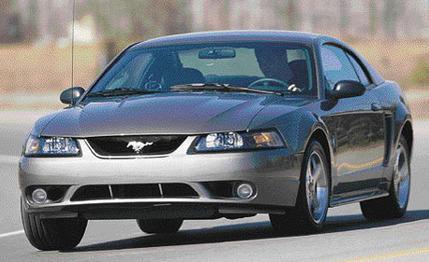
 Road Test
Road Test


We always thought we knew what Mustangs were all about: reasonably quick coupes that, despite being slower and less sure-footed then Camaros, still outsold the Chevy pony car by a margin of four to one. How could this be? Some say the Mustang looks better, or that the Camaro's bulked-up body turns off potential buyers.
Even though Ford is clearly killing Chevy at the showrooms, the Dearborn automaker made a variety of refinements to its SVT Mustang Cobra that it hoped would finally produce a Mustang that equaled a Camaro's quickness and agility. The Cobra's crude solid rear axle was replaced with an independent rear suspension in 1999, and the engine's output was boosted by 15 horses to 320—the same as in the killer 1998 Camaro Z28SS.


But Ford's hoped-for glory never materialized because, oddly enough, the enhanced horsepower didn't make the Cobra any quicker. The 1999 Cobra needed 5.5 seconds to get to 60 mph, about a half-second slower than the Camaro. We figured that although the Cobra had equal horsepower, the 5.7-liter pushrod Chevy V-8's significant torque advantage (345 pound-feet versus 317) over that of the revvy 32-valve DOHC Cobra V-8 gave the Camaro an edge at the drag strip.
It turns out that many of the Cobra's 15 new horses had jumped the fence—and it wasn't just our test car. About midway through the 1999 model year, Cobra owners, who thought their cars just didn't feel 320 horses strong, started taking their cars to dynos and testing them. Some Cobras were missing as much as 20 of the advertised horsepower. These guys were miffed. And they got on the horn in big numbers and began howling, "Where's the beef?"
By the time Ford discovered its horses weren't where its mouth was, then figured out a fix for each of the cars already sold and also designed new parts for production cars, there wasn't enough time to get the new parts into 2000 Cobras. As a result, Ford did not produce any for that model year. Ford now says 2001 is the first production year that all Cobras make 320 horsepower.
As you can imagine, we were quite eager to get into the latest Cobra model. We received the Mineral Gray 2001 model pictured here. The car felt strong, but it still didn't seem to have Camaro punch. Perhaps 320 horses was still optimistic.
Then we strapped on the test gear and made a few runs at the track. The results were staggering—the Cobra's acceleration time matched a Camaro SS's. The Cobra scooted to 60 mph in only 4.8 seconds and through the quarter in 13.5 seconds at 105 mph. Our last Z28SS (a particularly quick model we tested in October 1998) hit 60 mph in 4.9 seconds and did the quarter in 13.5 seconds at 107 mph.
"Must be a ringer," somebody offered. Had Ford slipped us an especially strong one? We asked for a second Cobra, and soon a white convertible arrived. We quietly drove both cars to the chassis dyno at Automotive Performance Engineering (APE) of Clinton Township, Michigan (810-954-3181; www.ap-engineering. com).
The technicians at APE strapped our gray coupe onto the dyno rolls and recorded 272 horsepower at the rear wheels. If you correct for driveline losses (about 15 percent), the rear-wheel dyno number correlates to 320 crankshaft horsepower, exactly as advertised. We then put the white convertible Cobra onto the dyno, and although we expected to see some typical production variation, we did not. It too made 272 rear-wheel horsepower. So you can take it from us: At least two 2001 Cobras produced the advertised 320 horsepower.